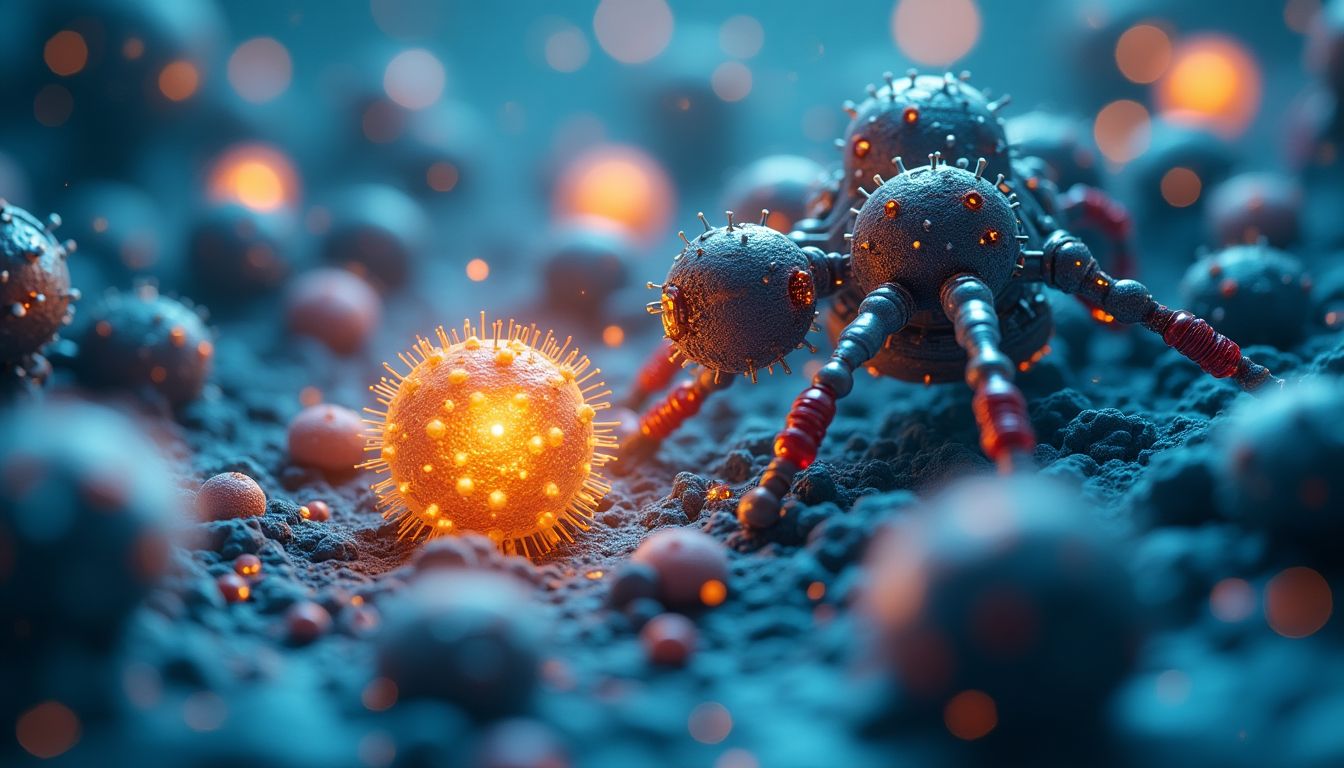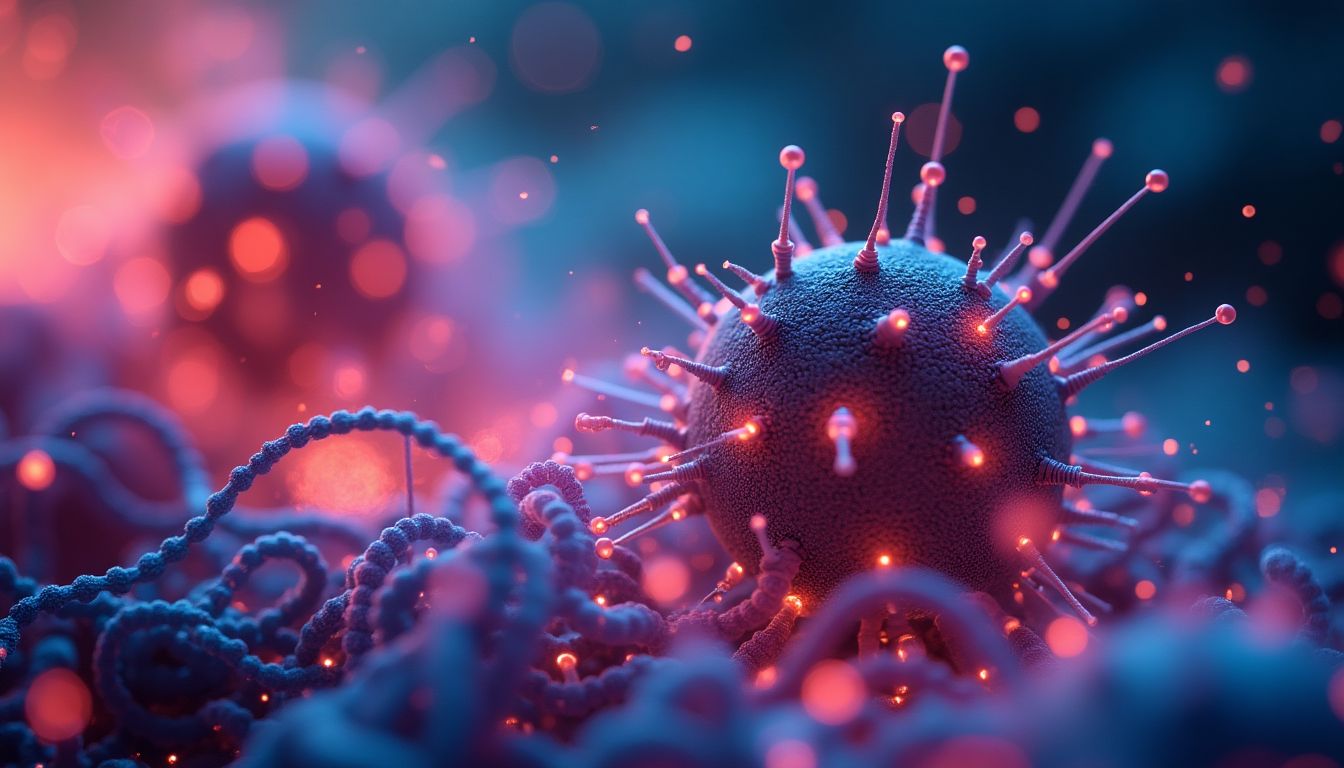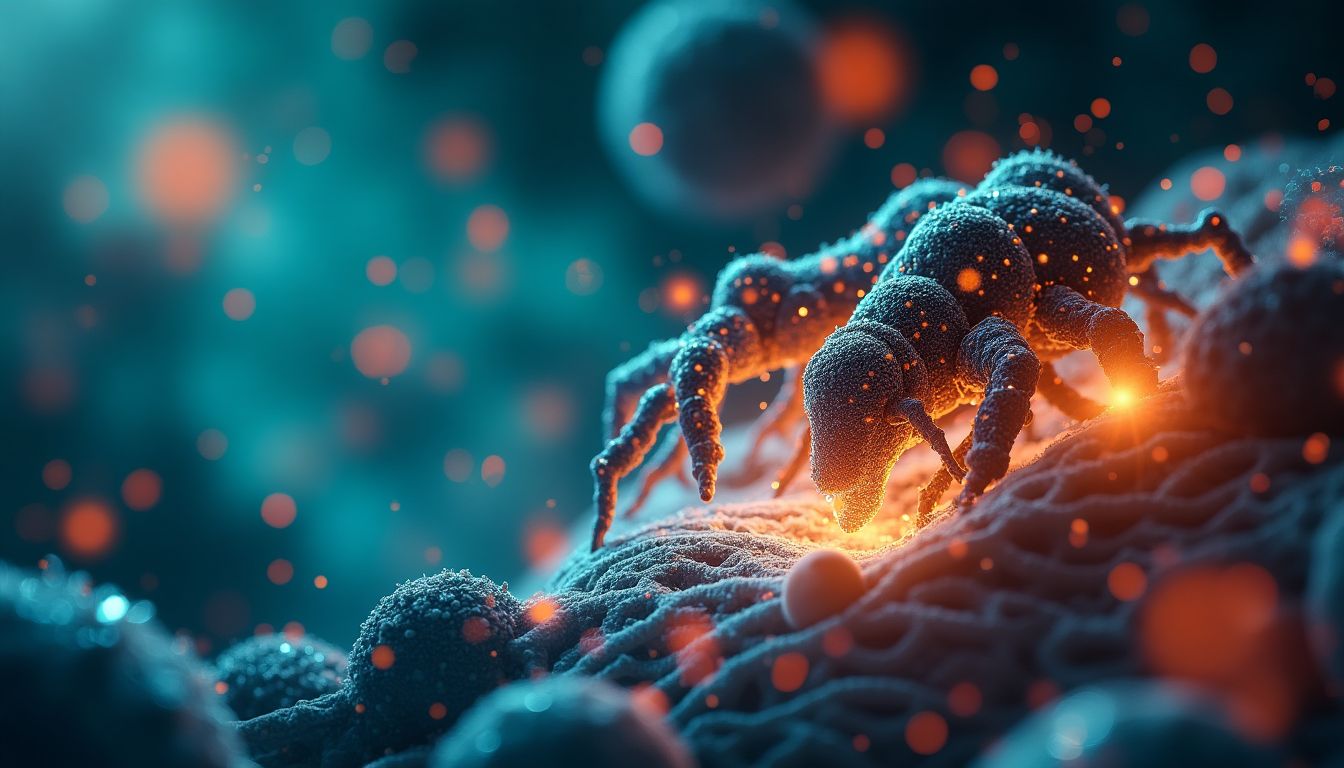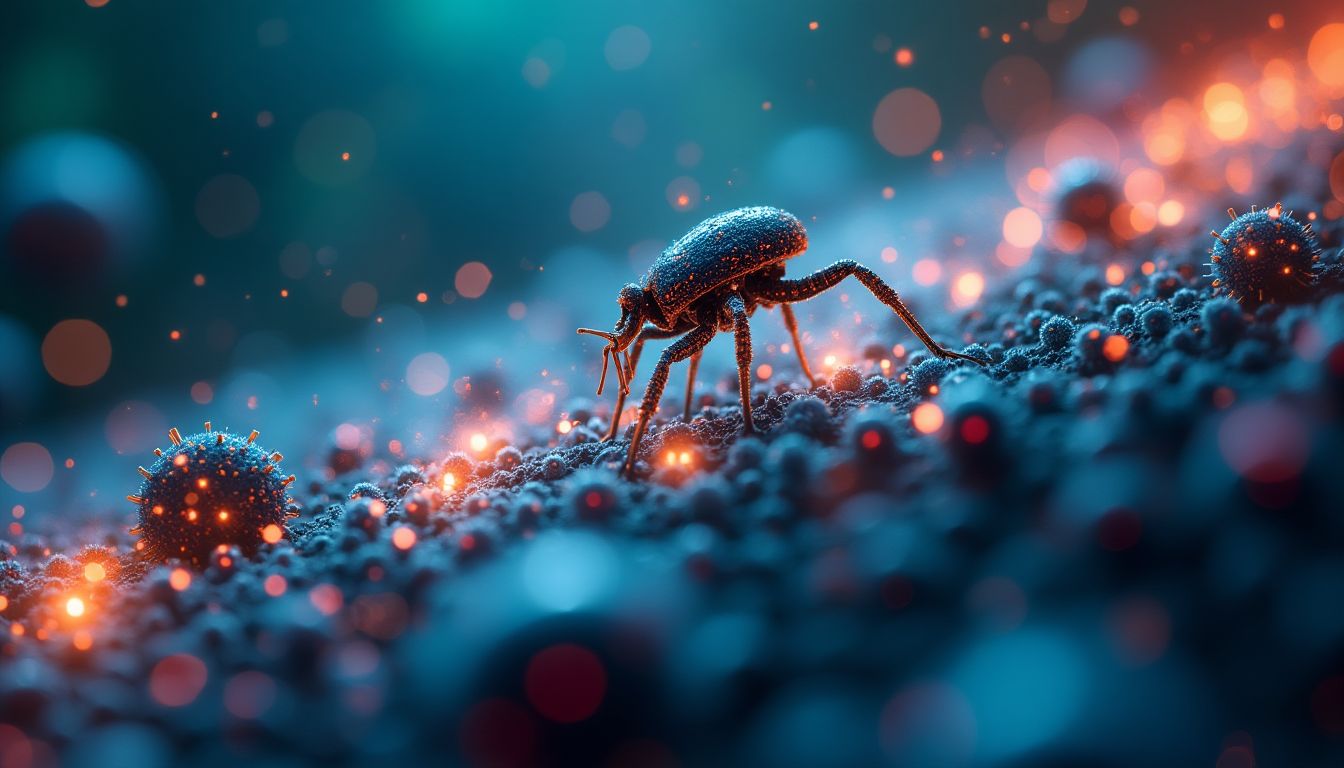What if the tiniest robots imaginable could swim through your bloodstream, repair damaged cells, or build materials atom by atom? This isn’t the plot of a sci-fi movie—it’s the future of molecular machines, powered by artificial intelligence (AI). These nanoscale robots, smaller than a grain of sand, are poised to revolutionize industries, medicine, and even our understanding of life itself. The convergence of nanotechnology, robotics, and AI is unlocking a new frontier of innovation, where the impossible becomes possible.
Molecular machines are devices so small they operate at the molecular level, performing tasks like transporting molecules, assembling structures, or delivering drugs. While the concept has been around for decades—think of the 2016 Nobel Prize in Chemistry awarded for the design of synthetic molecular machines—recent breakthroughs in AI and materials science are turning this vision into reality. Researchers like George Church, a pioneer in synthetic biology, and Nadrian Seeman, the father of DNA nanotechnology, have laid the groundwork for this transformative technology. Even Richard Feynman, the legendary physicist, famously predicted the potential of nanoscale machines in his 1959 lecture, “There’s Plenty of Room at the Bottom.”
But what makes this moment so exciting is the role of AI. By leveraging machine learning and advanced simulations, scientists are designing molecular machines with unprecedented precision and efficiency. These tiny robots could one day deliver drugs directly to cancer cells, clean up environmental pollutants, or even build futuristic materials atom by atom. The possibilities are as vast as the challenges are daunting. From technical hurdles to ethical dilemmas, the road to nanoscale robotics is anything but straightforward. But one thing is clear: the future of molecular machines is here, and it’s powered by AI.
1. The Science of Molecular Machines
1.1 What Are Molecular Machines?
Molecular machines are tiny devices that operate at the molecular level, performing specific tasks like transporting molecules or assembling structures. Think of them as microscopic robots, but instead of metal and wires, they’re made of molecules. These machines exist in nature—take ATP synthase, the enzyme that powers your cells, or kinesin, the protein that transports cargo inside your cells. Even ribosomes, the cellular factories that build proteins, are molecular machines.
Humans have also created synthetic molecular machines, like rotaxanes and catenanes, which are molecules that can move or rotate in response to stimuli. Then there’s DNA origami, where scientists fold DNA into intricate shapes to create nanoscale devices. These synthetic machines are still in their infancy, but they’re already showing incredible potential.
1.2 How Do Molecular Machines Work?
At the nanoscale, everything works differently. Molecular machines rely on principles like molecular recognition—where molecules “recognize” and bind to each other—and self-assembly, where molecules organize themselves into structures. For example, a molecular motor might convert chemical energy into mechanical motion, like a tiny engine. But controlling these machines is no easy feat. They’re so small that even the slightest disturbance can throw them off course.
This is where AI comes in. By simulating molecular dynamics, AI can predict how these machines will behave and help scientists design more stable and efficient systems. For instance, researchers at Caltech used AI to design a molecular switch that can be toggled with light. It’s like having a remote control for molecules—science fiction turned reality.
1.3 The Role of AI in Understanding Molecular Machines
AI is revolutionizing the way we study molecular machines. Traditional methods rely on trial and error, which is time-consuming and expensive. But with AI, scientists can simulate millions of molecular interactions in seconds, identifying the most promising designs before ever stepping into a lab. For example, Google DeepMind’s AlphaFold has already transformed our understanding of protein folding, a key process in molecular machines. By applying similar techniques, researchers are now designing molecular motors and switches with unprecedented precision.
But AI isn’t just about speed—it’s about creativity. Generative AI can propose entirely new molecular structures, some of which might never have occurred to human scientists. It’s like having a brainstorming partner who never sleeps. And as AI continues to evolve, so too will our ability to harness the power of molecular machines.
2. Industrial Applications of Nanoscale Robotics
2.1 Atomic-Scale Manufacturing
Imagine building a skyscraper, but instead of using bricks and steel, you’re assembling it atom by atom. Sounds like something out of a sci-fi movie, right? Well, atomic-scale manufacturing is no longer just a dream. Molecular machines could revolutionize industries by creating materials with unprecedented precision. Think about it: electronics with components so small they make today’s microchips look like bulky relics. Companies like IBM are already exploring this frontier, using nanotechnology to push the limits of what’s possible in computing.
But it’s not just about making things smaller. Atomic-scale manufacturing could lead to breakthroughs in energy storage, aerospace, and even consumer goods. Imagine batteries that last weeks instead of hours or airplanes that are lighter, stronger, and more fuel-efficient. The challenge? Scaling up these tiny marvels without losing precision. It’s like trying to build a Lego castle while wearing oven mitts—tricky, but not impossible.
2.2 Environmental Remediation
What if we could clean up oil spills or remove microplastics from the ocean using microscopic robots? Molecular machines could be the environmental heroes we’ve been waiting for. These nanobots could be designed to target specific pollutants, breaking them down or collecting them for safe disposal. For example, researchers at Caltech are working on nanobots that can neutralize harmful chemicals in water.
AI plays a crucial role here, optimizing the design of these machines to ensure they’re efficient and effective. Imagine a swarm of nanobots, each one programmed to seek out and destroy pollutants like a microscopic Pac-Man. The potential is enormous, but so are the challenges. How do we ensure these machines don’t cause unintended harm? And how do we deploy them on a large scale without breaking the bank? These are questions that scientists and engineers are racing to answer.
2.3 Self-Healing Materials
Ever wished your phone screen could fix its own cracks? With molecular machines, that might soon be a reality. Self-healing materials are already in development, and they’re as cool as they sound. Imagine a car that repairs its own scratches or a bridge that fixes its own cracks before they become a problem. Companies like DuPont are leading the charge, embedding molecular machines into polymers and composites to create materials that can heal themselves.
AI is key to designing these materials, simulating how they’ll behave under different conditions and optimizing their performance. The result? Products that last longer, perform better, and save us money in the long run. It’s like giving materials a built-in repair kit—no duct tape required.
3. Medical Applications of Molecular Machines
3.1 Targeted Drug Delivery
What if we could send tiny robots into your body to deliver medicine exactly where it’s needed? That’s the promise of targeted drug delivery using molecular machines. These nanobots could revolutionize how we treat diseases like cancer, delivering drugs directly to tumors without harming healthy cells. Companies like Nanobiotix are already working on this, using nanotechnology to enhance cancer treatments.
AI is the brains behind the operation, helping these nanobots navigate the complex landscape of the human body. Think of it like a GPS for your bloodstream, guiding the bots to their destination with pinpoint accuracy. The potential is huge, but so are the challenges. How do we ensure these machines are safe? And how do we make them affordable enough for widespread use? These are questions that researchers are tackling head-on.
3.2 Cellular Repair and Regeneration
Imagine a world where damaged cells can be repaired by microscopic robots. Sounds like something out of a superhero movie, right? Well, molecular machines could make this a reality. These nanobots could be programmed to repair DNA, fix damaged organelles, or even regenerate tissues. Researchers at Harvard University are already exploring this, using nanotechnology to repair cells at the molecular level.
AI is crucial here, simulating cellular processes and optimizing the design of these machines. The result? Treatments that are more effective and less invasive. But there are ethical considerations too. How do we ensure these machines don’t cause unintended harm? And how do we regulate their use? These are questions that scientists, ethicists, and policymakers are working to answer.
3.3 Diagnostics and Monitoring
What if we could detect diseases before they even show symptoms? Molecular machines could make this possible, monitoring your body in real-time and alerting you to potential health issues. These nanobots could be programmed to detect biomarkers for diseases like cancer, diabetes, or heart disease, giving doctors a head start on treatment.
AI is the key to making this work, analyzing the data collected by these machines and providing actionable insights. Imagine a future where your doctor gets a notification on their phone before you even feel sick. It’s like having a health guardian angel, watching over you 24/7. But there are challenges too. How do we ensure the privacy of this data? And how do we make these machines affordable enough for everyone? These are questions that researchers are working to answer.
4. Challenges in Developing Molecular Machines
4.1 Technical Challenges
Building molecular machines is like trying to assemble a watch with tweezers while wearing mittens. The precision required is mind-boggling. These machines operate at the nanoscale, where even the tiniest error can throw everything off. For example, creating a molecular motor that spins in a specific direction requires exact placement of atoms. One misstep, and it might spin backward—or not at all.
Energy is another hurdle. Molecular machines need power to function, but traditional batteries are way too big. Scientists are exploring alternatives like light, chemical reactions, or even the body’s own energy sources. But finding a reliable and efficient power source remains a challenge.
Stability is also a concern. Molecular machines must survive in environments that are often harsh or unpredictable. For instance, a nanobot designed to deliver drugs in the human body must withstand the immune system’s defenses and the body’s acidic conditions. Without stability, these machines could break down before completing their tasks.
4.2 Ethical and Societal Implications
As with any groundbreaking technology, molecular machines come with ethical dilemmas. What happens if a nanobot designed to clean up oil spills accidentally harms marine life? Or if a medical nanobot malfunctions and damages healthy cells? The potential for unintended consequences is real, and the stakes are high.
Privacy is another concern. Imagine nanobots monitoring your health in real time. While this could revolutionize medicine, it also raises questions about who has access to your data. Could insurance companies use this information to deny coverage? Could governments misuse it for surveillance?
Public acceptance is crucial. Many people are wary of nanotechnology, often due to misconceptions or fear of the unknown. Building trust will require transparency, education, and clear communication about the benefits and risks.
4.3 Economic and Industrial Barriers
Developing molecular machines isn’t cheap. The research and development costs are astronomical, and funding is often limited. Governments and private investors are hesitant to pour money into a technology that may take decades to yield returns.
Integrating molecular machines into existing industries is another challenge. For example, how do you incorporate nanoscale manufacturing into a factory designed for macro-scale production? Retooling entire industries will require significant investment and innovation.
Intellectual property disputes could also slow progress. With so many players—universities, corporations, and startups—collaboration is essential. But sharing knowledge and resources isn’t always easy, especially when patents and profits are involved.
5. The Future of Molecular Machines and AI
5.1 Emerging Technologies
The future of molecular machines is intertwined with advancements in other fields. Quantum computing, for instance, could revolutionize how we simulate and design these machines. Unlike classical computers, quantum computers can process vast amounts of data simultaneously, making them ideal for modeling complex molecular interactions.
Biomimicry—copying nature’s designs—is another exciting frontier. By studying natural molecular machines like ATP synthase, scientists can create more efficient synthetic versions. Biohybrid systems, which combine biological and synthetic components, could also play a key role.
Integration with the Internet of Things (IoT) is another possibility. Imagine a network of nanobots communicating with each other and with larger systems to perform complex tasks. This could lead to smart factories, self-healing infrastructure, and even intelligent medical devices.
5.2 Long-Term Vision
Molecular machines could become a cornerstone of the Fourth Industrial Revolution, transforming industries and addressing global challenges. For example, they could help combat climate change by capturing carbon dioxide or cleaning up polluted water. In medicine, they could eradicate diseases by repairing cells at the molecular level.
Looking further ahead, molecular machines might even play a role in space exploration. Imagine nanobots repairing spacecraft or building habitats on Mars. The possibilities are as vast as the universe itself.
5.3 Collaboration and Innovation
Realizing this vision will require collaboration across disciplines. AI researchers, nanotechnologists, biologists, and engineers must work together to overcome the challenges. Global initiatives, like the National Nanotechnology Initiative, are already fostering such collaboration.
Funding is also critical. Governments, corporations, and philanthropists must invest in this technology to accelerate progress. Organizations like the Bill & Melinda Gates Foundation are already supporting research in nanotechnology and AI.
Finally, inspiring the next generation of scientists and engineers is essential. Programs like FIRST Robotics are encouraging young people to explore STEM fields. By nurturing curiosity and creativity, we can ensure that the future of molecular machines is in capable hands.
6. AI Solutions: How Would AI Tackle This Issue?
6.1 AI-Driven Design and Simulation
Imagine a scenario where AI becomes the master architect of molecular machines. Using generative AI, researchers can design molecular machines with specific functions, tailored to tackle precise tasks. High-performance computing (HPC) plays a pivotal role here, enabling simulations of molecular dynamics that would take traditional methods centuries to compute. A groundbreaking case study is AlphaFold, which revolutionized protein folding predictions. This AI leap has profound implications for molecular machines, as it provides a blueprint for designing biomolecular structures that mimic natural systems.
6.2 Optimization and Control
Once designed, molecular machines need to be optimized. Reinforcement learning (RL) algorithms can fine-tune these nanobots for peak performance. Imagine an AI-guided nanobot navigating the human body to deliver a life-saving drug. RL algorithms, trained on millions of simulated scenarios, enable these nanobots to adapt in real-time, avoiding obstacles and optimizing their path. This is not just science fiction—researchers at MIT and Caltech are already pioneering these techniques.
6.3 Data Integration and Collaboration
Collaboration is key. Building open-source databases for molecular machine research democratizes access to critical data. AI platforms like Kaggle can host global competitions, encouraging researchers to crowdsource solutions. AI’s ability to analyze and synthesize vast amounts of scientific literature accelerates progress, uncovering hidden connections that might otherwise go unnoticed. For example, Nature and Science journals are now integrating AI tools to enhance research discovery.
6.4 Ethical AI and Risk Mitigation
With great power comes great responsibility. AI frameworks must assess risks and ethical implications. Transparency and accountability are non-negotiable. For instance, AI in biosecurity ensures that molecular machines are used for good, not harm. A case study in this realm is the Broad Institute, which uses AI to monitor and mitigate risks in genetic engineering. Ethical AI ensures that the development of molecular machines aligns with societal values.
Actions Schedule/Roadmap
Day 1: Assemble a multidisciplinary team, including AI experts, nanotechnologists, and biochemists. Contact leaders like Harvard and Stanford to spearhead the initiative.
Day 2: Define project goals, such as designing a molecular motor within six months. Use AI tools like IBM Quantum for initial simulations.
Week 1: Conduct a literature review. Leverage AI platforms like 
Frequently Asked Questions (FAQ)
Q1: What are molecular machines?
Molecular machines are tiny devices, smaller than a grain of sand, that can perform specific tasks at the nanoscale. Think of them as microscopic robots that can move, assemble, or transport molecules. These machines are inspired by natural systems like ATP synthase, which powers our cells, or kinesin, a protein that transports cargo inside cells. Scientists have also created synthetic versions, such as rotaxanes and DNA origami, which are designed to mimic these natural processes.
Q2: How does AI help in developing molecular machines?
AI is like the brain behind the brawn of molecular machines. It helps scientists design, simulate, and optimize these tiny devices. For example, AI can predict how molecules will behave under different conditions, which speeds up the development process. One groundbreaking example is Google DeepMind’s AlphaFold, which revolutionized protein folding predictions. This kind of AI can be applied to molecular machines, making it easier to create nanobots that can perform complex tasks, like delivering drugs to specific cells in the body.
Q3: What are the potential applications of molecular machines?
Molecular machines could change the world in ways we’re just beginning to imagine. Here are a few examples:
- Medicine: Nanobots could deliver drugs directly to cancer cells, reducing side effects and improving treatment outcomes.
- Manufacturing: Imagine building materials atom by atom, creating ultra-strong and lightweight materials for industries like aerospace.
- Environment: Molecular machines could clean up oil spills or remove pollutants from water at the nanoscale.
Companies like Nanobiotix are already exploring these possibilities in cancer treatment.
Q4: What are the biggest challenges in developing molecular machines?
While the potential is huge, there are still some major hurdles to overcome:
- Technical Precision: Building machines at the nanoscale requires extreme accuracy.
- Energy Needs: Powering these tiny devices is tricky—they need energy sources that work at such a small scale.
- Ethical Concerns: What happens if these machines get out of control? Could they harm the environment or be used in harmful ways?
Researchers at institutions like MIT and Caltech are working hard to address these challenges.
Q5: When will molecular machines become a reality?
Some applications, like targeted drug delivery, are already in development. However, widespread use of molecular machines might take another decade or more. It depends on how quickly we can solve the technical and ethical challenges. For example, IBM and other tech giants are investing heavily in nanotechnology, which could speed up progress.
Q6: Are molecular machines safe?
Safety is a big concern. Scientists are working to ensure that molecular machines are both effective and safe. For example, in medicine, nanobots would need to be designed to avoid harming healthy cells. Researchers are also exploring ways to control these machines remotely, so they can be shut down if something goes wrong. Organizations like the World Health Organization are keeping a close eye on these developments to ensure public safety.
Q7: How can I learn more about molecular machines?
If you’re curious about this exciting field, there are plenty of resources to explore. Check out the work of pioneers like George Church or Nadrian Seeman. You can also follow updates from leading research institutions like Stanford University or Max Planck Institute.
Q8: What role does AI play in ethical considerations?
AI isn’t just about making things faster or smarter—it’s also about making them safer. For example, AI can help predict potential risks of molecular machines, like unintended environmental impacts. It can also ensure that these technologies are developed transparently and responsibly. Groups like the Future of Life Institute are working to ensure that AI and nanotechnology are used for the benefit of humanity.
Q9: Can molecular machines be used in space exploration?
Absolutely! Imagine sending nanobots to Mars to build habitats or repair equipment. Molecular machines could play a key role in future space missions, helping us explore and colonize other planets. NASA and private companies like SpaceX are already thinking about how nanotechnology could revolutionize space travel.
Q10: How can I get involved in this field?
If you’re passionate about science and technology, there are many ways to get involved. You could study nanotechnology, AI, or molecular biology at universities like Harvard or Oxford. You could also join research projects or internships at companies like IBM or Google DeepMind. The future of molecular machines is just beginning, and there’s plenty of room for innovators like you!
Wait! There's more...check out our gripping short story that continues the journey: The Symphony Beneath Our Skin
Disclaimer: This article may contain affiliate links. If you click on these links and make a purchase, we may receive a commission at no additional cost to you. Our recommendations and reviews are always independent and objective, aiming to provide you with the best information and resources.
Get Exclusive Stories, Photos, Art & Offers - Subscribe Today!




























Post Comment
You must be logged in to post a comment.